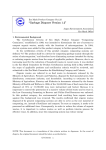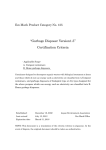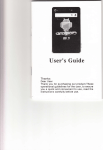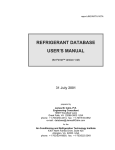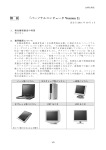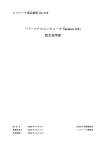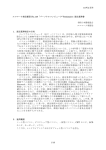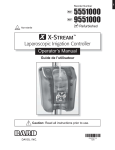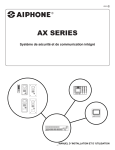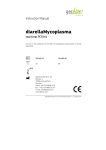Download “Personal Computers Version 2.10” Certification Criteria
Transcript
119V2 Criteria
Eco Mark Product Category No.119
“Personal Computers Version 2.10”
Certification Criteria
Established: August 3, 2006
Japan Environment Association
Revised: April 1, 2015
Eco Mark Office
Expiration date: August 31, 2016
NOTE: This document is a translation of the criteria written in Japanese. In the event
of dispute, the original document should be taken as authoritative.
119V2 Criteria
Eco Mark Product Category No.119
“Personal Computers Version 2.10”
Certification Criteria
Japan Environment Association
Eco Mark Office
1. Purpose of Establishing Certification Criteria
The personal computer (“PC”) market in Japan is large and still growing. According
to the Japan Electronics and Information Technology Industries Association, domestic PC
shipments in fiscal 2004 (ended March 31, 2005) totaled more than 13,039,000 units, for
an annual growth rate of approximately 10%.
Some of the characteristics that typify PCs are an international distribution and a
short product cycle that is hastened by factors such as rapid advances in PC-related
technologies and high upgrade demand.
Society has been moving to address the environmental aspects of PCs. Over the past
five years, for example, the Japanese government has led an initiative to begin collecting
and recycling end-of-life PCs in accordance with the Japanese Law for the Promotion of
Effective Utilization of Resources. The government has also spearheaded an initiative to
further advance PC energy efficiency in accordance with the Energy Conservation Law
(Law Concerning the Rational Use of Energy). Internationally, measures are being
promoted to restrict the use of harmful substances under the EU RoHS Directive and to
examine eco-design requirements under the EuP Directive. In Japan, it was a period of
significant advances. For example, standards on marking that contains certain specified
substances were established within Japanese Industrial Standards; and, moreover, in
September 2005 voluntary industry guidelines on PC volatile organic compound (VOC)
emissions were drafted. The certification criteria for PCs have been completely revised to
make
them
consistent
with
these
social
imperatives.
The
criteria
describe
environmentally considerate PCs based on the latest knowledge and information, and
new criteria for VOC emissions have been added and a checklist for 3R design has been
optimized.
PCs are distributed internationally. Accordingly, when undertaking a revision of
certification criteria, consideration must be paid to cooperation with interested
organizations around the world. Japan, a member of GEN (the Global Ecolabelling
Network, an international association with 27 member organizations from the U.S.,
Germany, the Nordic countries, South Korea and more), is strengthening and promoting
cooperation with overseas eco-labeling programs implemented by third-party certification
organizations, and common global certification criteria for PCs have been established in
the past. In addition, Japan, China and South Korea are cooperating on eco-labeling, and
cooperation among the various interested organizations is moving forward, with, for
example, the organizations launching an investigation into establishing common
1/26
119V2 Criteria
certification criteria.
This product category was established on September 10, 2000, as a new product
category for eco mark certification after being selected along with copiers and other office
equipment for eco mark eligibility with the introduction of the product life cycle concept
in the 1996 revision of the Guidelines for Eco Mark Program Implementation. Five years
have passed since the certification criteria were established. Accordingly, the product
category criteria were revised pursuant to “6. Discontinuance of Product Categories and
Revision of Certification Criteria” in Chapter II of “Guidelines for Eco Mark Program
Implementation.” The goal in revising the criteria is to promote the spread of
environmentally considerate PCs. Toward that end, care was taken to make the
application process easier by, for example, alleviating the complicated and troublesome
procedures associated with certificates and other evidentiary documentation, which were
one of the factors hindering the spread of Eco Mark certified products.
2. Applicable Products
This Eco Mark product category applies to notebook PCs, desktop PCs, all-in-one PCs (a
PC with integrated monitor), CRT monitors, LCD monitors, keyboards, and mouse
devices.
This product category also includes thin clients*1 and tablet PCs*2.
*1
Thin client: A terminal that is attached to an organization’s information system network. Thin clients
offer enhanced security because client PCs possess only the essential functions, while application
software, files and other assets are managed by a server.
Normally, thin clients do not have an internal magnetic disk or other means of storage.
*2
Tablet PC: A personal computer that emphasizes features such as portability and viewing ease for
business applications and that is treated as a type of notebook PC.
3. Terminology
Housing
Refers primarily to outer covers that form the external
appearance of the product. A housing protects the device from
environmental effects and maintains user safety. Displays, key
tops, FDDs/ODD, connectors, LEDs, power switches, slide pads
and other objects exposed on the surface of a housing are not
considered part of the housing.
Housing
A small object weighing less than 25g that is attached to a
appurtenance
housing, such as a connector cover and option cover.
Copolymer
A polymer consisting of two or more types of monomers.
(Examples include ABS, etc.)
2/26
119V2 Criteria
Reused part
A part that has previously been used and that is reused in a
product.
Recycled plastic
Plastic raw material composed of post-consumer material and
raw material
pre-consumer material.
Pre-consumer
Material or rejected product generated from a disposal route in
material
a product manufacturing process, excluding those that are
generated in a material manufacturing process and that are
reused as raw materials within the same process (plant).
Post-consumer
Materials or products disposed of after they have been used as
material
goods.
Minimum
The shortest period of time that a manufacturer shall keep a
retention period
performance part in question after discontinuing production of
a product that uses the part.
Chassis
A frame that is provided inside a housing and that is needed to
support the housing and main parts of a PC. When a housing
also serves as a chassis, as in a notebook PC, its external
appearance function takes precedence and it is treated as a
housing.
Prescribed
A material component added for the intended purpose of giving
constituent
certain characteristics to a product. Impurities that are
technically unavoidable in the manufacturing process are not
included.
Sub-assembly:
Assembly consisting of at least two components that are joined
together in a force- or positive-fit manner.
Electrical/electroni
Assembly that includes at least one electronic or electric part.
c sub-assembly:
Batteries
Refers to both primary batteries and secondary batteries. A
primary battery discharges only once, while a secondary
battery can be recharged for repeated use.
Instruction manual Documentation that is primarily intended to describe the use
(user manual):
and handling of the equipment. This does not include
documentation that provides information on subjects other
than the use and handling of the equipment in question. In this
product category “instruction manual” shall be construed to
include CD-ROMs, websites and other electronic media.
Homopolymer
Single polymer. Polymer consisting of one type of monomer.
(Examples include PS, PC, PP, etc.)
Polymer
High molecular material that is the main constituent of plastic.
Polymer alloy
General name of multi-component polymers obtained by
(Polymer blend)
mixing or chemically binding the polymers of more than two
3/26
119V2 Criteria
components. A polymer blend is a physical blending of different
types of polymers. (Examples include PC/ABS, etc.)
Life cycle
One of the techniques used to objectively assess the
assessment
environmental impacts of a product or service (referred
collectively to as “product” below) throughout its entire
life-cycle, from the extraction of resources through to the
manufacture, use, recycling, disposal and distribution of the
product.
Recycling
Materials recycling only; energy recovery (thermal recycling) is
not included.
4. Certification Criteria and Certification Procedure
[Partial Mutual Recognition among Chinese Environmental Labeling and Korea
Eco-Labeling]
If the applying product is already certified by Chinese Environmental Labeling (HJ/T
313-2006 Microcomputers and displays: January 2007) or Korea Eco-Labeling (EL144.
Personal Computers & Monitors [EL144-1999/4/2005-68]), JEA will consider common
items shown in Appendix 1 are complied with above labeling programs’ certification.
4-1. Environmental Criteria and Certification Procedure
(1) The product shall conform to Attachment 1, “PC 3R Design Checklist.”
[Certification Procedure]
The applicant shall fill out and submit Attachment 1, “PC 3R Design Checklist.”
(2) The product shall conform to Attachment 2, “PC Substance Checklist.”
[Certification Procedure]
The applicant shall fill out and submit Attachment 2, “PC Substance Checklist.”
(3) The product shall conform to Attachment 3, “Efforts in PC Manufacturing Plant.”
[Certification Procedure]
The responsible person or the manager of the plant that manufactures the product
shall fill out and submit Attachment 3, "Efforts in PC Manufacturing Plant."
(4) The applicant shall perform a product life-cycle assessment (LCA), strive to reduce
the amount of energy consumed during manufacture, and provide information to
equipment users.
[Certification Procedure]
Submit an Attached Certificate that indicates the following:
a. Whether an LCA has been performed (or is planned) for the representative model
4/26
119V2 Criteria
b. Whether you have or plan to provide information on the LCA results for the
representative model
c. The means (website, catalog, etc.) that you use or plan to use to provide
information.
d. Whether there are past PC LCA results
An application can be submitted for a PC series. In this case, one or more models in
the series may be considered representative models. To be considered
representative, a model must have the highest energy consumption in the series,
and LCA results for that model must be submitted along with information on the
model and its specifications.
(5) The product shall conform to Attachment 4, “Energy-Saving PC Design Checklist.”
However, this item does not apply to thin clients, keyboards and mouse devices.
[Certification Procedure]
The applicant shall fill out and submit Attachment 4, “Energy-Saving PC Design
Checklist.”
(6) The product’s A-weighted emission sound pressure level (dB) per item 3.2.5 in ISO
9296 shall not exceed 40 dB in idle mode. In operating mode (when accessing a hard
disk or optical disk), it shall not exceed 45 dB. However, this item does not apply to
keyboards and mouse devices.
[Certification Procedure]
The applicant shall submit test records for a representative model. An application
can be submitted for a PC series. In this case, the highest A-weighted emission
sound pressure level value in the series shall be considered the test record of the
representative model.
(7) The product shall conform to Attachment 5, “Checklist for Providing PC
Information.”
[Certification Procedure]
The applicant shall fill out and submit Attachment 5, “Checklist for Providing PC
Information.”
(8) The product shall conform to Attachment 6, “PC Packaging Materials Checklist.” (This
does not apply to items that are issued beyond the applicant’s control, such as
CD-ROM cases and instruction manuals for basic software.)
[Certification Procedure]
The applicant shall fill out and submit Attachment 6, “PC Packaging Materials
Checklist.”
(9) The product shall not use antimicrobial agents (including fungicides) as far as possible.
5/26
119V2 Criteria
In the case of the use, the product shall be certified by the SIAA Mark of Society of
Industrial technology for Antimicrobial Articles, etc.
[Certification Procedure]
In the case of using antibacterial agents, documents certifying SIAA Mark of
Society of Industrial technology for Antimicrobial Articles, etc. shall be submitted.
4-2. Quality Criteria and Certification Procedure
(10) Products shall conform to safety standards that are in accordance with IEC 60950
(published by the International Electrotechnical Commission).
[Certification Procedure]
The applicant shall submit a certificate providing evidence that the product
conforms to safety standards that are in accordance with IEC 60950.
5. Considerations
In manufacturing products, it is desirable to consider the following, although they are not
requirements for certification. The conformance to the individual criteria item shall be
indicated in Attached Certificates.
(1) Instruction manuals (user manuals) provided to users shall conform to the following
“a.” to “c.”
a. The binding method shall not impede waste paper recycling. A hot-melt adhesive
used to bind a manual shall be one of a modified non-dispersive EVA hot-melt
adhesive, a polyurethane hot-melt adhesive and a water-soluble hot-melt adhesive.
However the use of other hot-melt adhesives is permitted for manuals printed
outside Japan.
b. Chlorine gas shall not be used in the bleaching process of waste paper pulp.
c. The percentage of waste paper in the pulp mixture shall be over 70%.
However, this item is not applied to the manuals printed outside Japan.
6. Product Classification, Labeling, etc.
(1) The product classification (application unit) shall be either a model or a series.
Products shall not be classified by color or size.
A single application can be used to apply for multiple models in the same series, but
each model or device in the series shall satisfy the respective criteria.
In the product classification, a separate application can be submitted for accessory
equipment included in desktop PC and all-in-one PC configurations. For products
that are sold primarily as a part of a system, a CRT monitor, LCD monitor, keyboard
and mouse devices may be included along with the computer itself in the same
6/26
119V2 Criteria
application. In this case each piece of equipment shall satisfy the respective criteria.
(2) The environmental information shown below shall be indicated below the mark.
However, the indication of Eco Mark and certification information (Type B
indication) can be allowed by following “Guide to Eco Mark usage” (enforced on
March 1, 2011). The location and details of the Eco Mark to be indicated shall be
submitted when applying for Eco Mark product certification and use.
The environmental information shall be indicated as “3R & energy-saving design” on
the first line and enclosed in a rectangular box.
For the products certified under Eco Mark No.119 “Personal Computers”, it is
approved to indicate the same environmental information below Eco Mark and
certification number as those used under previous product category in the indication
below Eco Mark based on this product category as in the past.
A sample Eco Mark is shown below.
XXXX (contractor for the Eco Mark)
Eco Mark Certification No. XXXXXXXX
(allowable with numbers only)
August 3, 2006
Version 2.0 established
October 19, 2006
Revised Version 2.1
April 13, 2007
Revised Version 2.2
Feb. 14, 2008
Revised Version 2.3
August 21, 2008
Revised Version 2.4
April 28, 2009
Extension of Expiration date
March 1, 2011
Revised Version 2.5
April 1, 2011
Revised Version 2.6
October 1, 2011
Revised Version 2.7
August 1, 2012
Revised Version 2.8
August 1, 2013
Revised Version 2.9
April 1, 2015
Revised Version 2.10
August 31, 2016
Expiration date
The certification criteria for this product category shall be revised as appropriate.
7/26
119V2 Criteria
Appendix 1.
Corresponding table to common items among Chinese Environmental Labeling and Korea
Eco-Labeling
Eco Mark No.119
China Environmental Labeling
Personal Computer
HJ/T 313-2006 Microcomputers
Ver.2
and displays
Korea Eco-Labeling
EL144. Personal Computers
EL145. Notebook Computers
EL147. Monitor for Personal
Computers
4-1.(1)
Attachment 1
No.1
-
-
Attachment 1
No.2
5.2.2 (4)
-
Attachment 1
No.3
-
-
Attachment 1
No.4
5.2.2 (3)
-
Attachment 1
No.5
-
-
Attachment 1
No.6
-
-
Attachment 1
No.7
-
-
Attachment 1
No.8
-
-
Attachment 1
No.9
-
-
Attachment 1
No.10
5.2.2 (1)
3.1.5.1
Attachment 1
No.11
5.2.1 (2)
3.1.5.2 b)
Attachment 1
No.12
-
-
Attachment 1
No.13
-
-
Attachment 1
No.14
-
-
Attachment 1
No.15
-
-
Attachment 1
No.16
-
-
Attachment 1
No.17
5.2.1 (3)
3.1.5.2 c)
Attachment 1
No.18
-
-
Attachment 1
No.19
-
-
Attachment 1
No.20
-
-
Attachment 1
No.21
-
-
Attachment 2
No.1
-
3.1.3.3
Attachment 2
No.2
-
-
Attachment 2
No.3
-
-
Attachment 2
No.4
-
-
Attachment 2
No.5
-
-
Attachment 2
No.6
-
-
Attachment 2
No.7
-
3.1.3.1, 3.1.3.2, 3.1.3.3
Attachment 2
No.8
-
-
Attachment 3
No.1
5.4.6 (1)
-
Attachment 3
No.2
-
-
4-1.(2)
4-1.(3)
8/26
119V2 Criteria
Eco Mark No.119
China Environmental Labeling
Personal Computer
HJ/T 313-2006 Microcomputers
Ver.2
and displays
Attachment 3
No.3
4-1.(4)
Korea Eco-Labeling
EL144. Personal Computers
EL145. Notebook Computers
EL147. Monitor for Personal
Computers
5.4.6 (2)
-
-
-
4-1.(5)
Attachment 4
1. No.1
-
-
Attachment 4
1. No.2
5.1.3
-
Attachment 4
1. No.3
-
-
Attachment 4
2. No.1
-
-
-
-
4-1.(6)
4-1.(7)
Attachment 5
No.1
-
-
Attachment 5
No.2
-
-
Attachment 5
No.3
-
-
Attachment 5
No.4
-
-
Attachment 5
No.5
-
-
Attachment 6
No.1
-
-
Attachment 6
No.2
-
-
Attachment 6
No.3
5.4.5
3.1.4.2 c)
Attachment 6
No.4
-
-
4-2.(9)
-
-
4-2.(10)
-
-
4-1.(8)
※If the cell of Chinese Environmental Labeling or Korea Eco-Labeling is filled in above chart, there will
be no need to submit documents for Eco Mark’s application in case the applying product is certified
by each labeling program.
9/26
119V2Attached Certification
Attachment 1: PC 3R Design Checklist [corresponds to item 4-1.(1) of certification criteria]
《Category》
M: Requirement that must be met
Date of Issue:
S: Requirement that should be met
Issued by (Company name)
On this checklist, all "M" items must be answered "Yes."
(1) Grey column for "Requirement Applicability":- Compliance must be indicated for all items in the "Compliance" column.
(2) Optional:
- Check whether the requirement is applicable to the applying product, and if it is applicable, indicate in the "Compliance" column whether the product is compliant. If the item is not
applicable, provide the reason.
(Example of a non-applicable item: No. 1 (1) For equipment that does not have metal-inserted molded parts, check "Not applicable" and write "no metal insert molding" as the reason.
- For "S" category requirements that were not implemented, check "Not applicable" and write "Not implemented" as the reason.
- If the product does not contain the applicable part, check "Not applicable," and write "No such part" as the reason.
Applicable products: notebook PCs, desktop PCs, all-in-one PCs (PCs with integrated monitor), CRT monitors, LCD monitors, keyboards, and mouse
Please provide answers in the areas enclosed by the bold line.
List Catego
No.
Requirement
Applicable Part
For parts, the same types of metal materials and plastic materials are used as long as
functionality is not impaired.
Plastic parts,
ry
Requirement Applicability
Compliance
Ease with which part can be reused or recycled
1
2
M
M
Metals in molded parts with metal inserts shall be separable by cutting, pulverizing or
otherwise breaking down the part. "
housing, housing
□ Applicable
parts, chassis
[Reason:
Plastic parts
□ Applicable
4
M
M
Plastic parts made of thermoplastics that are inseparable with common tools due to
bonding, welding, crimping or other fastening technique shall be compatible with one
another according to Table 1 "Compatibility of thermoplastics".
Plastic parts
Plastic parts shall be made from a single homopolymer or copolymer. Polymer blends
(polymer alloys), however, may be used.
Plastic parts
M
Plastic parts shall be composed of up to two types of mutually separable polymers or
polymer blends.
]
□
No
□
No
□ Yes
□ Not applicable
Plastic parts
No
□ Yes
□ Applicable
]
□ Applicable
□
No
□ Yes
□ Not applicable
[Reason:
10/26
]
□ Not applicable
[Reason:
□
□ Yes
□ Applicable
[Reason:
5
]
□ Not applicable
[Reason:
3
□ Yes
□ Not applicable
]
□
No
119V2Attached Certification
6
S
Metal plated and conductively coated plastic parts shall be avoided. Is direct printing on
plastic parts kept to the bare minimum (such as the manufacturer's name)?
Housing, housing
parts
Plastic parts that have a surface coating over a large area must be processed to remove
the coating for recycling. Laser marking and similar marking methods are not considered
"printing" for these purposes. This item does not apply to plastic parts whose coating is
made of the same material as the part.
7
S
At least one part shall contain recycled plastic material or recycled magnesium alloy.
Also, the recycled material content of parts containing these recycled materials shall be at
least 5 wt%.
The denominator of the content percent shall be the unit weight of a part containing
recycled plastic or recycled magnesium alloy, and the numerator shall be the content
weight of the recycled material.
Recycled content (wt%) =
□ Applicable
□ Yes
□ Not applicable
[Reason:
]
□
No
Housing, housing
parts, chassis
□ Applicable
□ Yes
□ Not applicable
Recycled content by weight
[Reason:
]
□
No
Unit weight of part with recycled content
The use of recycled plastics containing specified brominated flame retardants (PBBs,
PBDEs) or chlorinated paraffin shall be avoided.
8
S
The weight of products shall not exceed 20 kg. Products that exceed 20 kg in weight shall
have handles or design elements for safety during transport.
Notebook PCs,
desktop PCs,
When applying for certification as a system that includes a computer and monitor, etc., no all-in-one PCs, CRT
monitors, LCD
component shall exceed 20 kg.
□ Applicable
□ Yes
□ Not applicable
[Reason:
]
□
No
monitors
Ease of separation / disassembly (including ease of pulverization / incineration)
9
M
Can subassemblies such as printed circuit boards and optical drives be separated from the
chassis, housing and other subassemblies? Also, can cojoined subassemblies that are
made of a material listed in Table 1 be separated or they fastened together by an element
that assists separation?
The joints between a housing and a chassis and between a chassis and an electronic
subassembly are important, and their separability is a prerequisite for 1) separating
subassemblies and materials for reuse and recycling, and thus 2) for the safe and quick
removal of parts that contain harmful substances. A "part that assists separation" refers
to things such as break points in predetermined locations to facilitate the separation of
subassemblies from one another with the minimum level of destruction.
10
M
Can joints that should separate be easily found?
Housing parts,
chassis, electronic
subassemblies
Housing, chassis
□ Yes
□
□ Yes
□
11/26
No
No
119V2Attached Certification
Joints that should separate during disassembly shall be such that they can easily and
quickly be found. When screws are hidden by design, steps shall be taken to assist
disassembly. For example, marks can be placed near locations where there are hidden
joints that should be separated, and information on joints that should be separated can be
provided to recyclers.
11
M
Can disassembly for recycling be completed with common tools?
Housing, chassis,
Common tools" means to commonly available tools. Excludes wireless equipment defined
by the Japan Radio Law and AC adapter housings.
12
M
S
□
subassemblies
Batteries shall be replaceable and removable by equipment users. This does not apply to Primary batteries and
□ Applicable
batteries that are mounted to printed circuit boards or other components that are not secondary batteries
□ Not applicable
supposed to be removed by equipment users.
[Reason:
“Removable" means battery removal corresponding to items A, B or C in Table 2.
13
□ Yes
electronic
Batteries that are mounted to printed circuit boards or other components that are not Primary batteries
supposed to be removed by equipment users shall have a life of at least 10 years. These
batteries shall be replaceable or removable at the end of the product's life or during
repairs and so forth, without having to replace the entire printed circuit board or other
component on which they are mounted.
Batteries corresponding to items A through F in Table 2.
□ Yes
]
□ Applicable
□
No
□ Yes
□ Not applicable
[Reason:
No
]
□
No
Ease of sorting parts, etc.
14
M
Plastic parts
Large plastic parts shall carry markings that are in line with ISO 11469 (JIS K 6999),
□ Applicable
with material symbols that are compliant with ISO 1043 (JIS K 6899). This excludes light weighing 25g or more
□ Not applicable
or having a flat area
guides and optical sheets used in LCD displays.
of 200 mm2 or more.
[Reason:
□ Yes
]
□
No
Use of recycled parts and recycled materials
15
S
Is it possible to install recycled subassemblies and so forth in the product?
At the evaluation, check whether such parts can be used according to the specs.
Preferably, manufacturers can install recycled parts in equipment as spare parts or as
ETN (equivalent to new) parts. An "ETN part" means a reused part that is equivalent to a
new part.
Computer
subassemblies &
parts
□ Applicable
□ Yes
□ Not applicable
[Reason:
]
□
No
Long use
16
M
Can system performance be upgraded?
Computer
12/26
□ Applicable
□ Yes
119V2Attached Certification
Product life can be extended by upgrading system performance. Specifically, items such as
CPUs, optical drives, HDDs, and main memory can be upgraded, and the system comes
with expansion slots, etc. System upgradeability requires that specific conditions be met
from the start.
17
M
M
□
□ Not applicable
[Reason:
No
]
Can the system be expanded with new functions?
It should be possible to extend the life of a product by enabling functional expansion, i.e.
the addition of other equipment (TV, facsimile) functions. At the examination, check the
preconditions for enabling functional expansion. Example: Is there space for expansion
slots.
18
subassemblies
Desktop PC
subassemblies
Notebook PCs,
The applicant shall retain performance parts for equipment repairs for a minimum period
desktop PCs,
of five years. ("Performance parts" means parts that are essential for maintaining the
all-in-one PCs, CRT
functioning of a product.)
monitors, LCD
□ Applicable
□ Yes
□ Not applicable
[Reason:
]
□ Applicable
No
□ Yes
□ Not applicable
[Reason:
□
]
□
No
monitors
19
M
Notebook PCs,
The applicant shall set up a repair service to repair Eco Mark certified equipment and
desktop PCs,
shall perform repairs at the request of equipment users. The applicant shall provide the
all-in-one PCs, CRT
following:
monitors, LCD
□ Applicable
□ Yes
□ Not applicable
[Reason:
]
□
No
monitors
Process records
20
M
Were materials selected in accordance with items 1 through 5 of this checklist, and were
records kept?
□ Applicable
Housing, chassis
[Reason:
21
M
Did the manufacturer perform a trial disassembly in accordance with items 9 through 13
of this checklist, and were records kept?
13/26
Total unit
□ Yes
□ Not applicable
]
□
No
□ Yes
□
No
119V2Attached Certification
Table 1: Compatibilities prescribed in item No. 1 (2)
VDI 2243, Part 1, 30/42 Table 2: Compatibilities of thermoplastics [49;67]
PVC
PS
PC
PP
PA
POM
SAN
ABS
PBTP
PETP
PMMA
Base
material
Important plastics
for design
PE
Additives
PE
PVC
PS
1
4
4
4
1
4
4
4
1
4
4
4
1
4
4
4
4
4
4
4
4
4
1
4
4
2
4
4
4
4
4
4
4
4
1
4
PC
4
3
4
1
4
4
4
1
1
1
1
1
PP
PA
POM
3
4
4
4
4
4
4
3
4
4
4
4
1
4
4
4
1
4
4
4
1
4
4
4
4
4
4
4
3
3
4
3
4
4
4
4
SAN
ABS
4
4
1
2
4
4
1
1
4
4
4
4
4
3
1
4
1
1
4
3
4
3
1
1
PBTP
PETP
4
4
4
4
4
3
1
1
4
4
3
3
4
4
4
4
3
3
1
4
4
1
4
4
PMMA
4
1
3
1
4
4
3
1
1
4
4
1
1: Compatible
2: Compatible, with some limitations
3: Compatible in small amounts
4: Uncompatible
14/26
119V2Attached Certification
Table 2: Facility of disassembling a battery in item No.8
Designation
Range
Sign
Item
Classification
A
One-touch
One-touch
Power unit is off-line system, and battery (packing) can be taken out by
one-touch
B
Removal of cover by
hand
One-touch
Removal of cover by hand is possible, and battery (packing) can be taken out
by one-touch
Connector
removing
Removal of cover by hand is possible, and battery (packing) can be taken out
by removing connector
One-touch
Removal of cover by screw is possible, and battery (packing) can be taken out
by one-touch
Connector
removing
Removal of cover by screw is possible, and battery (packing) can be taken out
by removing connector
Easy
Removal of batteries
C
Difficult
Example of item evaluation
Subclass
Removal of cover by
screw
D
Removal of cover by
screw
Cutting
Removal of cover by screw is possible, and battery (packing) can be taken out
by cutting the connection with nippers etc.
E
Decomposition of the
whole(screw
removing)
Connector
removing.
Decomposition of the whole by removing screw is possible and the battery
(packing) can be taken out by removing the connector
F
Decomposition of the
whole
(screw
removing)
Cutting
Decomposition of the whole by removing screw is possible, and battery
(packing) can be taken out by cutting the connection with nippers etc.
G
Decomposition of the
whole
(dismantlement)
Connector
removing
Dismantling the whole and the battery (packing) can be taken out by
removing the connector
Cutting
Dismantling the whole and battery (packing) can be taken out by cutting the
connection with nippers etc.
15/26
119V2Attached Certification
Attachment 2: PC Chemical Substance Checklist [corresponds to item 4-1. (2) of the certification criteria]
On this checklist, all items must be answered "Yes," except where "Not applicable" is checked in the
"Applicability of Requirement" column.
Date of Issue:
(Issuer: Company / plant name)
発
<<Requirement Applicability>>
(1) Grey column for "Requirement Applicability":
Compliance must be indicated for all items in the "Compliance" column.
(2) Optional in "Requirement Applicability":
If the product does not contain the applicable part, check "Not applicable," and write "No such part or region" as the reason.
Applicable products: notebook PCs, desktop PCs, all-in-one PCs (PCs with integrated monitor), CRT monitors, LCD monitors, keyboards, and mouse devices.
Please provide answers in the areas enclosed by the bold line.
List No.
1
2
3
Requirement
Applicable Part Requirement Applicability
Compliance
Specified brominated flame retardants (PBBs, PBDEs) or short-chained chlorinated paraffin
(with a carbon chain count of from 10 to 13 and a chlorine concentration of 50% or more, as in
Printed circuit
all discussions below) shall not be added as prescribed constituents.
boards
Printed circuit board means a bare printed circuit board that does not include semiconductor
chips, etc.
□ Yes
□ No
Halogenated polymers and organic halogenated compounds shall not be added as prescribed
constituents. This item does not apply, however, when the applicant takes back and either
□ Applicable
reuses or recycles the applicant's Eco Mark certified equipment under the Wide Area
Housing,
□ Not applicable
Certification System (Special exception system related to regional management of wastes
housing parts
based on the Waste Disposal and Public Cleaning Law, Article 9-9, and Article 15-4-3.).
[Reason:
This excludes parts containing organic fluorine additives used to improve physical
characteristics of plastic materials (such as anti-dripping agents with a content not exceeding
0.5 wt%) and parts weighing less than 25g.
□ Yes
□ No
□ Applicable
Substances (level 1, 2A, and 2B) classified as carcinogenic by the IARC (International Agency
Housing,
□ Not applicable
for Research on Cancer) at the time the Eco Mark application is submitted for the equipment
shall not be added as prescribed constituents. This does not apply, however, to titanium yellow, housing parts
[Reason:
antimony trioxide and carbon black.
16/26
]
□ Yes
□ No
]
119V2Attached Certification
Of the above substances enumerated by the IARC, the terms of inclusion described below in
the seventh item shall take precedence for lead, cadmium, hexavalent chromium, mercury and
specified brominated fire retardants (PBBs, PBDEs). This item shall not apply to substances
to which the seventh item herein applies. The following examples describe the reasoning with
regard to prescribed constituents.
Formaldehyde, the raw material for polyoxymethylene resin (polyacetal resin: POM) used in
housings, is a raw material for personal computer (PC) housings and not a substance intended
for direct use in a PC. Since the resin produced by reacting the raw material is what is used for
PC housings, and since formaldehyde itself is not used with the intention of serving as a PC
housing, formaldehyde is not considered to be added as a prescribed constituent.
Likewise, styrene monomer, the raw material for polystyrene resin, is not considered to be
added as a prescribed constituent. The reasoning is that the resin produced by reacting the
styrene monomer is used for PC housings, while the styrene monomer itself is not intended for
use as a PC housing.
Unreacted styrene monomer present in housings is also not considered to be added as a
prescribed constituent."
4
5
□ Applicable
Display parts (panel materials such as glass, liquid crystal, and polarizers; and backlight
Notebook PCs,
□ Not applicable
materials such as fluorescent lamps, light-guides and optical sheets) shall not contain level 1,
all-in-one PCs,
2A, or 2B substances, which the IARC classifies as carcinogenic, as prescribed constituents.
LCD monitors
[Reason:
However, this item does not apply to mercury, antimony, arsenic and arsenic compounds.
Cadmium, lead and mercury shall not be added as prescribed constituents.
Applies to single-cell batteries. Does not apply to solder and so forth used to interconnect
single-cell batteries.
6
Secondary batteries shall be identified in accordance with the Battery Association of Japan's
identification and labeling guidelines for small rechargeable batteries.
Primary
batteries and
□ Yes
□ No
]
□ Applicable
□ Yes
□ No
□ Not applicable
secondary
batteries
[Reason:
]
□ Applicable
Secondary
□ Yes
□ No
□ Not applicable
batteries
[Reason:
7
The percentage content of lead, cadmium, hexavalent chromium, mercury, and specified
brominated fire retardants (PBBs, PBDEs) shall not exceed the reference values enumerated
for these specified substances in JIS C 0950, a Japanese Industrial Standard that specifies the
method for indicating the content of specified substances contained in electrical and electronic
equipment.
17/26
Product
]
□ Yes
□ No
119V2Attached Certification
If an applicable substance qualifies as an exception under content marking rules, the content
information shall be disclosed on a website. This item applies to batteries that equipment
users are not supposed to remove. This item does not apply to batteries that equipment users
may remove.
8
The rate of volatile organic compounds (VOC) emissions from the product shall not exceed the Product (This
item does not
guideline values shown below in Table 1.
The definition of VOC, measurement method, applicable substances and so forth are as
provided in "VOC Guidelines for Personal Computers (PC-VOC-G-2005)," drafted by the Japan
Electronics and Information Technologies Industries Association. If the Eco Mark application
is submitted for a PC series, the VOC emissions shall be checked for one or more models that
are expected to produce the highest level of emissions.
apply when an
□ Applicable
application is
□ Not applicable
submitted for
keyboards and [Reason:
mouse devices
alone.)
Table 1: Guideline values for VOC emission rates provided for in List No. 8
Unit: micro-grams/(h x unit)
18/26
□ Yes
□ No
]
119V2Attached Certification
Attachment 3 - "Efforts in PC Manufacturing Plant" Checklist [corresponds to item 4-1. (3) of certification criteria]
・Applicable products: notebook PCs, desktop PCs, all-in-one PCs, CRT monitors,
LCD monitors, keyboards, mouse devices
Date of Issue:
Issuer: (Company / plant name)
Issuer: Name and title
(All of the three requirements below must be answered "yes")
List
No.
1
The issuer is the responsible person or manager of the plant that manufactures the product)
Requirement
Compliant
The plant that conducts final assembly of the product shall not use any
of the five specified types of CFCs, other CFCs, carbon tetrachloride or
trichloroethane listed in Table 1, nor shall the plant emit any of the
replacement CFCs (“HCFCs”) listed in the table.
□ Yes
□ No"
This does not include plant equipment that is not directly related to the
product manufacturing process, such as air-conditioners and
refrigerators.
2
In manufacturing the applied product, related environmental laws and
regulations and pollution control agreement (hereinafter referred to as
the “Environmental Laws, etc.”) must be followed with respect to air
pollution, water contamination, noise, offensive odor, and emission of
hazardous substances in the area where the plant performing the final
manufacturing process is located. However, this item does not apply to
soil contamination that occurred prior to the institution of controls on
the polluting substances in question.
The state of compliance with the Environmental Laws, etc. for the past
five years from the date of application (whether there is any violation)
must be reported. If there is any violation, proper remedies and
preventive measures shall have been already taken, and the related
Environmental Laws, etc. must thereafter be followed appropriately.
However, this item does not apply to soil contamination that occurred
prior to the institution of controls on the polluting substances in
question.
note
The applicants shall report whether there is any violation in
the
past
five
years,
including
a
violation
subject
to
administrative punishment or administrative guidance, and if
□ Yes
□ No"
there is, the following documents in a and b must be submitted:
a. With respect to the fact of violation, guidance documents
from administrative agencies (including order of correction
and warning) and copies of written answers (including
those reporting causes and results of correction) to such
□ We have not violated any
related Environmental Laws,
documents (clearly indicating a series of communication);
b. Following materials (copies of recording documents, etc.)
etc. for the past five years.
concerning the management system for compliance with the
□ We have not violated any
1) List of the Environmental Laws, etc. related to the area
related Environmental Laws,
etc. since foundation of the
Company in (year).
19/26
Environmental Laws, etc. in 1)-5):
where the plant is located;
2) Implementation system (organizational chart with roles,
etc.);
119V2Attached Certification
In the table in the lower right, list the names of environmental laws and
regulations that are being observed.
If the final assembly plant is new or has not been in operation for five
years by the time an application is filed, the plant shall not have had
any reportable violations since it began operations."
3) Bylaws stipulating retention of recording documents;
□ We violated related
Environmental Laws, etc. in the
past five years, have already
4)Recurrence
prevention
measures
(future
preventive
measures);
5) State of implementation based on recurrence prevention
taken proper remedies and
measures (result of checking of the state of compliance,
recurrence prevention
including the result of onsite inspection)
measures, and thereafter
comply with the related
Environmental Laws, etc.
properly.
3
It is clearly evident that none of any of the specified five types of CFCs,
other CFCs, carbon tetrachloride or trichloroethane listed in Table 1 is
used in plants that manufacture parts used in the product. It is clearly
evident that plants that manufacture parts used in the product are not
emitting HCFCs or are working to reduce such emissions.
The person with responsibility for the application shall submit
documentation of the materials required in plant’s green
purchasing, etc. as evidence that plants manufacturing parts
□ Yes
□ No"
used in the product do not use or emit any of the substances
listed in Table 1.
This does not include plant equipment that is not directly related to the
product manufacturing process, such as air-conditioners and
refrigerators.
List the environmental laws and regulations that are being
Table 1 – CFCs, etc.
5 types of specified CFCs
Other
CFCs
HCFCs
observed by the plants defined in No. 2.
Trichlorofluoromethane
Dichlorodifluoromethane
Trichlorotrifluoroethane
Chlorotrifluoromethane
Pentachlorofluoromethane
Tetrachlorodifluoroethane
Heptachlorofluoropropane
Hexachlorodifluorpropane
Carbon Tetrachloride
1,1,1-Trichloroethane
Dichlorofluoromethane
Chlorodifluoromethane
Chlorofluoroethane
Tetrachlorofluoroethane
Trichlorodifluoroethane
Dichlorotrifluoroethane
Chlorotetrafluoroethane
Trichlorofluoroethane
Dichlorodifluoroethane
Chlorotrifluoroethane
Dichlorofluoroethane
Chlorodifluoroethane
Chlorofluroethane
Hexachlorofluoropropane
Pentachlorodifluoropropane
Tetrachlorotrifluoropropane
Trichlorotetrafluoropropane
Dichlorotetrafluoroethane
Chloropentafluoroethane
Pentachlorotrifluoropropane
Tetrachlorotetrafluoropropane
Trichloropentafluoropropane
Dichlorohexafluoropropane
Chloroheptafluoropropane
Dichloropentafluoropropane
Chlorohexafluoropropane
Pentachlorofluoropropane
Tetrachlorodifluoropropane
Trichlorotrifluoropropane
Dichlorotetrafluoropropane
Chloropentafluoropropane
Tetrachlorofluoropropane
Trichlorodifluoropropane
Dichlorotrifluoropropane
Chlorotetrafluoropropane
Trichlorofluoropropane
Dichlorodifluoropropane
Chlorotrifluoropropane
Dichlorofluoropropane
Chlorodifluoropropane
Chlorofluoropropane
20/26
119V2Attached Certification
Attachment 4-1: Energy-Saving PC Design Checklist [corresponds to item 4-1. (5) of certification
criteria]
*Applicable products: Notebook PCs, desktop PCs, all-in-one
PCs (PCs with integrated monitor), CRT monitors, LCD
Date of Issue:
Issued by (Company
name)
monitors. This item does not apply to thin clients.
* If simultaneously applying for both the computer and the monitor in a desktop PC, fill out both parts 1 and 2.
1. For notebook PCs, desktop PCs and all-in-one PCs, fill out the information below.
(All of the three requirements below must be answered "Yes".)
List No.
Requirement
Compliance
The PC shall satisfy either a) or b).
□ Yes
a) The energy-saving standard achievement rate of the product calculated
□ No
according to Table 1 shall be 200% or over. Table 1 indicates the applicable (In caser of a),
standard energy consumption efficiency for the 2011 fiscal year for "computers," compliance shall
designated equipment under “Japan's Law Concerning the Rational Use of
be indicated
Energy”.
1
2
3
above.
In case of b), the
b) A product shall conform to the ENERGY STAR® “Product Specification for applicant shall
submit “a written
Computers: Eligibility Criteria” that is applied at the time of application.
notice on products
using the
ENERGY STAR®
logo”, etc. for each
model)
The PC shall be equipped with a power switch and power consumption in the off
state shall be less than 1W. If the computer is required to operate other functions
(functions to supply power to a clock, monitor modem or LAN wake signals,
monitor battery charge, and illuminate LEDs to notify equipment users of
equipment status, etc.) when the power switch off, power consumption shall not
exceed 5W.
The functions of the PC are not impaired even if the PC's power plug is removed
from an electrical outlet and the PC is left unplugged for a relatively long period of
time (at least four weeks). (The loss of date, time or other clock information is not
considered to be an impairment
□ Yes
□ No
□ Yes
□ No
List 1. Standard energy consumption efficiency for applying model
model
category
ex. EC22M/Y
P
Standard energy consumption efficiency
energy-saving standard
standard value
notified value
achievement rate
0.31
0.22
1. This refers to a numeric value measured by the method defined in 3(2) of"Criteria
for Judgment of Manufacturer, etc. on Improvement of Performance of Computers”.
21/26
119V2Attached Certification
Table 1 Standard energy consumption efficiency per the Law
Category
Type of power source and the
number of memory channels
of client-electronic computer
Main Memory
Independent
Capacity
GPU
Battery-driven computer
16 Gigabytes or
whose number of memory
more
channels is equal to or greater
than 2
Standard energy
Monitor size
Category
consumption
efficiency
M
2.25
N
0.34
17 or more
P
0.31
equipped
less than 17
Q
0.21
unequipped
from 12 to 17
R
0.15
less than 12
S
0.21
T
0.29
U
2.25
From 4 gigabytes
to less than 16
gigabytes
less than 4
gigabytes
Among computers other than
battery-driven computers
whose number of memory
channels is equal to or greater
than 2, those using an AC
adapter as a power unit
Among computers other than
16 Gigabytes or
battery-driven computers
more
whose number of memory
From 4 gigabytes
equipped
V
0.51
channels is equal to or greater
to less than 16
unequipped
W
0.64
than 2, those not using an AC
gigabytes
X
0.53
Y
0.51
adapter as a power unit
less than 4
gigabytes
Computer whose number of
memory channels is less than
2
Note)
1. "The number of memory channels" refers to that of physical channels of a bus interface to a main memory diverging from a memory
controller.
2. A "battery-driven type" refers to a computer that can be used with a battery embedded in itself and without being supplied with
electricity from a power line.
3. An "independent type GPU” refers to a computer having a dedicated local memory, of processors for image data processing.
4."Screen size" refers to a numeric value to be obtained by dividing a numeric value representative of a diagonal outside diameter
dimensions of a display screen in centimeters by 2.54 and rounding it to one decimal place.
5. A method for computing the energy consumption efficiency shall be according to"3 Method for Measuring Energy Consumption
Efficiency (2)" of the Ministerial Announcement No. 74 (March 31, 2010) of the Ministry of Economy, Trade and Industry, which is
based on Law Concerning the Rational Use of Energy.
22/26
119V2Attached Certification
Attachment 4-2: Energy-Saving PC Design Checklist [corresponds to item 4-1. (5) of certification
criteria]
・Applicable products: CRT monitors, LCD monitors
・If simultaneously applying for both the computer and
the monitor in a desktop PC, fill out both parts 1 and 2.
Date of Issue:
Issued by (Company
name)
2. For CRT / LCD monitors, fill out the information below.
(The requirement below must be answered "Yes.")
List No.
Requirement
Compliance
□ Yes
□ No
1
The monitor shall meet the criteria for displays
(monitors) in the International Energy Star
Program which applies at the time of application.
Attached Certificate
Please attach Notification of
Product (Display) Using
International Energy Star
Program Logo (Attachment
4-2A).
Remarks) The standards and measurement methods shall conform to International Energy Star Program Operational
Regulations.
23/26
119V2Attached Certification
Attachment 5:
Checklist for Providing PC Information [corresponds to item 4-1. (7) of the certification criteria]
On this checklist, all items must be answered "Yes," except where "Not applicable" is checked
in the "Applicability of Requirement" column.
Date of Issue:
Issued by (Company
name)
<<Requirement Applicability>>*
- Check whether the requirement is applicable to the applying product, and if it is applicable, indicate in the "Compliance" column whether the product is
compliant. If the item is not applicable, provide the reason.
(Example: No. 4 For equipment that does not have a secondary battery, check "Not applicable" and write "no secondary battery" as the reason.) Indicate whether
the information is included in instruction manuals, on websites, and in catalogs by checking "Yes" or "No" as appropriate in every cell.
- If the applying product does not correspond to an applicable product, check "Not applicable," and write "Not applicable" as the reason.
Applicable products: Notebook PCs, desktop PCs, all-in-one PCs, CRT monitors, LCD monitors, keyboards, and mouse devices.
Please provide answers in the areas enclosed by the bold line.
List
No.
1
Requirement
Applicable
Product
Information shall be provided on the minimum retention period for Notebook PCs,
performance parts used for repairs prescribed in item No. 18 of desktop PCs,
all-in-one PCs,
Certification Criteria Attachment 1, "PC 3R Design Checklist."
CRT monitors,
Compliance
Requirement
Applicability
□ Applicable
□ Not applicable
[Reason:
]
Instruction
Website product
Manual*1
information*2
□ Yes
□ No
□ Yes
□ No
□ Yes
□ No
□ Yes
□ No
Catalog
□ Yes
□ No
LCD monitors
2
3
4
Information shall be provided on compliance involving repairs All products
prescribed in item No. 19 of Certification Criteria Attachment 1,
"PC 3R Design Checklist."
□ Applicable
□ Not applicable
[Reason:
Information on battery replacement shall be provided. This does All products
not apply in instances where, for example, batteries are mounted
to a printed circuit board or other component that is not supposed
to be removed by equipment users.
□ Applicable
□ Not applicable
[Reason:
For equipment that has a secondary battery, information or labels All products
shall be provided in accordance with the Law for the Promotion of
Effective Utilization of Resources so as to (1) communicate that the
equipment has a secondary battery, and (2) promote the use of
secondary batteries as a recyclable resource.
□ Yes
□ No
]
□ Applicable
□ Not applicable
[Reason:
24/26
]
*3
□ Yes
□ No
]
*3
□ Yes
□ No
119V2Attached Certification
The maximum power consumption in operation and the power Notebook PCs,
5
consumption in an idle state (the minimum power consumption in desktop PCs,
all-in-one PCs,
an operating state) shall be provided.
CRT monitors,
□ Applicable
□ Not applicable
[Reason:
]
□ Yes
□ No
□ Yes
□ No
LCD monitors
*1
*2
*3
: The information required in instruction manuals may also be provided via a combination of different mediums, such as paper, the Web, a CD-ROM and so forth.
: "Product information" means information on product characteristics, specifications, appearance and so forth.
: This information may be provided by establishing links in online instruction manuals to product information on a website.
25/26
□ Yes
□ No
119V2Attached Certification
Attachment 6: PC Packaging Checklist [corresponds to item 4-1. (8) of the certification criteria]
Date of Issue:
Issued by (Company
On this checklist, all items must be answered "Yes."
name)
Applicable products: Notebook PCs, desktop PCs, all-in-one PCs (PCs with integrated monitor), CRT monitors, LCD monitors, keyboards, and mouse devices
Please provide answers in the areas enclosed by the bold line.
List
No.
1
Requirements
Plastic materials used for packaging shall carry markings that are in line with ISO 11469 (corresponding to
JIS K 6999: 2004), with material symbols that are compliant with ISO 1043: 1997 (corresponding to JIS K
6899: 2000). However, it shall be permissible to omit material labeling in compliance with identifying mark
relating items such as "Plain containers and packaging" and "Unlabelable containers and packaging" in the
Law for the Promotion of Effective Utilization of Resources.
Compliance
□ Yes
□ No
2
Efforts shall be made to facilitate packaging material resource conservation, reuse and recycling in compliance
with guidelines for preparing manuals on product design pre-evaluations to help promote the use of recycled
resources (July 1994 Waste Processing and Recycling Subcommittee of the Industrial Structure Council).
□ Yes
□ No
3
None of the five specified types of CFCs, other CFCs, or HCFCs listed in Table 1 in Attachment 3 shall be used
in packaging materials.
□ Yes
□ No
4
Halogenated polymers and organic halogenated compounds shall not be added as prescribed constituents of
plastic materials use in packaging.
□ Yes
□ No
* Packaging material:
"Packaging material, material that is included with a product package at the time of shipping, is broadly divided into two types: (1) main unit
shipping carton, a bag for wrapping the main unit, and main unit packing, including cushioning material; and (2) packaging for accessory
items such as instruction manuals and power cords.
Examples of packaging materials include shipping paperwork, shipping labels, cover letters, wire-core plastic cable ties, bar code label for
package tracking (consisting of paper, ink, and adhesive), warranty card bag, packaging tape, sealing tape, adhesives used inside cardboard
boxes for packing, shrink pack, plastic handles that come with cardboard boxes, bundling bands, and so on.
This does not apply to items that are not issued by the applicant, such as packaging for basic software instruction manuals and CD-ROM
cases. "
26/26



























